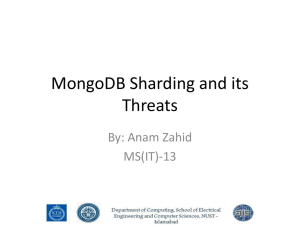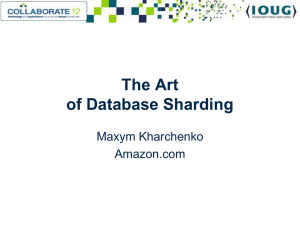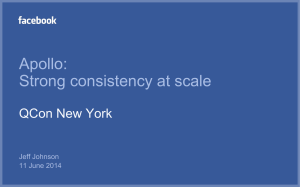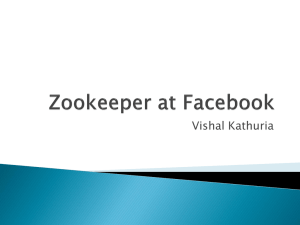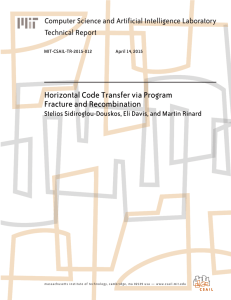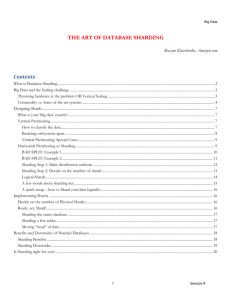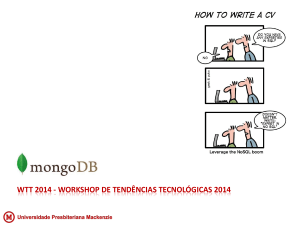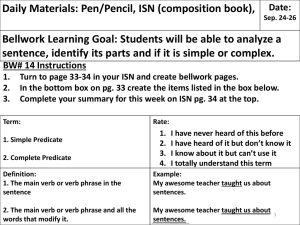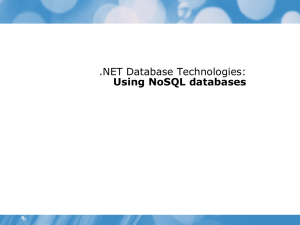MongoDB Auto
advertisement
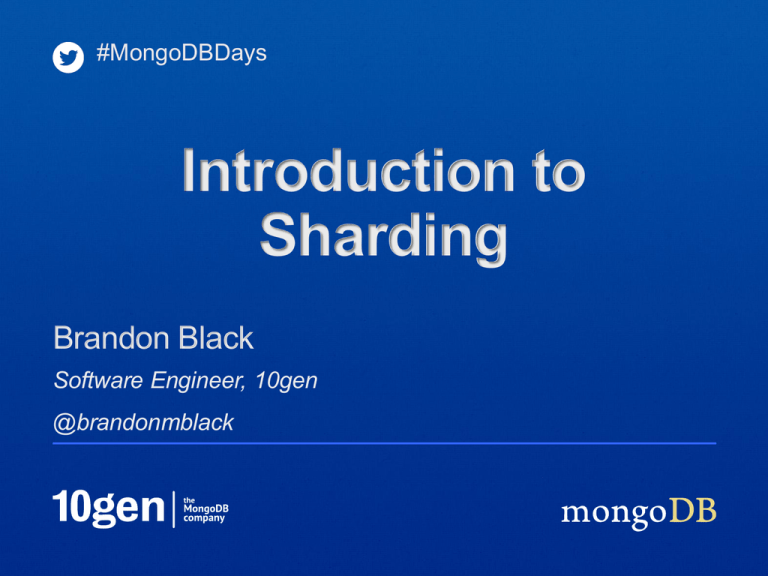
#MongoDBDays
Introduction to
Sharding
Brandon Black
Software Engineer, 10gen
@brandonmblack
Agenda
• Scaling Data
• MongoDB's Approach
• Architecture
• Configuration
• Mechanics
Scaling Data
Examining Growth
• User Growth
– 1995: 0.4% of the world’s population
– Today: 30% of the world is online (~2.2B)
– Emerging Markets & Mobile
• Data Set Growth
– Facebook’s data set is around 100 petabytes
– 4 billion photos taken in the last year (4x a decade ago)
Read/Write Throughput Exceeds I/O
Working Set Exceeds Physical
Memory
Vertical Scalability (Scale Up)
Horizontal Scalability (Scale Out)
Data Store Scalability
• Custom Hardware
– Oracle
• Custom Software
– Facebook + MySQL
– Google
Data Store Scalability Today
• MongoDB Auto-Sharding
• A data store that is
–
–
–
–
–
100% Free
Publicly available
Open-source (https://github.com/mongodb/mongo)
Horizontally scalable
Application independent
MongoDB's Approach
to Sharding
Partitioning
• User defines shard key
• Shard key defines range of data
• Key space is like points on a line
• Range is a segment of that line
Data Distribution
• Initially 1 chunk
• Default max chunk size: 64mb
• MongoDB automatically splits & migrates chunks
when max reached
Routing and Balancing
• Queries routed to specific
shards
• MongoDB balances cluster
• MongoDB migrates data to
new nodes
MongoDB Auto-Sharding
• Minimal effort required
– Same interface as single mongod
• Two steps
– Enable Sharding for a database
– Shard collection within database
Architecture
What is a Shard?
• Shard is a node of the cluster
• Shard can be a single mongod or a replica set
Meta Data Storage
• Config Server
– Stores cluster chunk ranges and locations
– Can have only 1 or 3 (production must have 3)
– Not a replica set
Routing and Managing Data
• Mongos
– Acts as a router / balancer
– No local data (persists to config database)
– Can have 1 or many
Sharding infrastructure
Configuration
Example Cluster
• Don’t use this setup in production!
- Only one Config server (No Fault Tolerance)
- Shard not in a replica set (Low Availability)
- Only one mongos and shard (No Performance Improvement)
- Useful for development or demonstrating configuration mechanics
Starting the Configuration Server
• mongod --configsvr
• Starts a configuration server on the default port (27019)
Start the mongos Router
• mongos --configdb <hostname>:27019
• For 3 configuration servers:
mongos --configdb
<host1>:<port1>,<host2>:<port2>,<host3>:<port3>
• This is always how to start a new mongos, even if the cluster
is already running
Start the shard database
•
•
•
•
mongod --shardsvr
Starts a mongod with the default shard port (27018)
Shard is not yet connected to the rest of the cluster
Shard may have already been running in production
Add the Shard
• On mongos:
- sh.addShard(‘<host>:27018’)
• Adding a replica set:
- sh.addShard(‘<rsname>/<seedlist>’)
Verify that the shard was added
• db.runCommand({ listshards:1 })
{ "shards" :
[{"_id”: "shard0000”,"host”: ”<hostname>:27018” } ],
"ok" : 1
}
Enabling Sharding
• Enable sharding on a database
sh.enableSharding(“<dbname>”)
• Shard a collection with the given key
sh.shardCollection(“<dbname>.people”,{“country”:1})
• Use a compound shard key to prevent duplicates
sh.shardCollection(“<dbname>.cars”,{“year”:1, ”uniqueid”:1})
Tag Aware Sharding
• Tag aware sharding allows you to control the
distribution of your data
• Tag a range of shard keys
sh.addTagRange(<collection>,<min>,<max>,<tag>)
• Tag a shard
sh.addShardTag(<shard>,<tag>)
Mechanics
Partitioning
• Remember it's based on ranges
Chunk is a section of the entire range
Chunk splitting
• A chunk is split once it exceeds the maximum size
• There is no split point if all documents have the same shard
key
• Chunk split is a logical operation (no data is moved)
Balancing
• Balancer is running on mongos
• Once the difference in chunks between the most dense shard
and the least dense shard is above the migration threshold, a
balancing round starts
Acquiring the Balancer Lock
• The balancer on mongos takes out a “balancer lock”
• To see the status of these locks:
use config
db.locks.find({ _id: “balancer” })
Moving the chunk
• The mongos sends a moveChunk command to source shard
• The source shard then notifies destination shard
• Destination shard starts pulling documents from source shard
Committing Migration
• When complete, destination shard updates config server
- Provides new locations of the chunks
Cleanup
• Source shard deletes moved data
- Must wait for open cursors to either close or time out
- NoTimeout cursors may prevent the release of the lock
• The mongos releases the balancer lock after old chunks are
deleted
Routing Requests
Cluster Request Routing
• Targeted Queries
• Scatter Gather Queries
• Scatter Gather Queries with Sort
Cluster Request Routing: Targeted
Query
Routable request received
Request routed to appropriate shard
Shard returns results
Mongos returns results to client
Cluster Request Routing: Non-Targeted
Query
Non-Targeted Request Received
Request sent to all shards
Shards return results to mongos
Mongos returns results to client
Cluster Request Routing: Non-Targeted
Query with Sort
Non-Targeted request with sort
received
Request sent to all shards
Query and sort performed locally
Shards return results to mongos
Mongos merges sorted results
Mongos returns results to client
Shard Key
Shard Key
• Shard key is immutable
• Shard key values are immutable
• Shard key must be indexed
• Shard key limited to 512 bytes in size
• Shard key used to route queries
– Choose a field commonly used in queries
• Only shard key can be unique across shards
– `_id` field is only unique within individual shard
Shard Key Considerations
• Cardinality
• Write Distribution
• Query Isolation
• Reliability
• Index Locality
Conclusion
Read/Write Throughput Exceeds I/O
Working Set Exceeds Physical
Memory
Sharding Enables Scale
• MongoDB’s Auto-Sharding
– Easy to Configure
– Consistent Interface
– Free and Open-Source
• What’s next?
–
–
–
–
Hash-Based Sharding in MongoDB 2.4 (2:50pm)
Webinar: Indexing and Query Optimization (May 22nd)
Online Education Program
MongoDB User Group
• Resources
https://education.10gen.com/
http://www.10gen.com/presentations
http://www.10gen.com/events
http://github.com/brandonblack/presentations
#MongoDBDays
Thank You
Brandon Black
Software Engineer, 10gen
@brandonmblack
